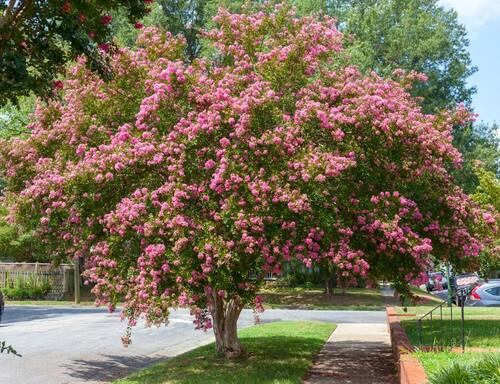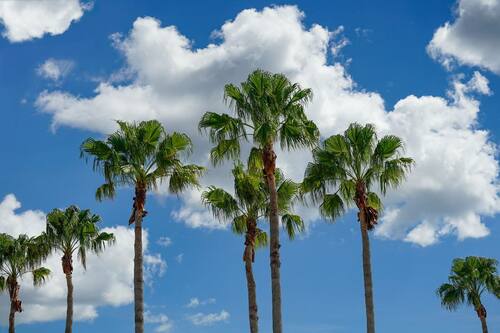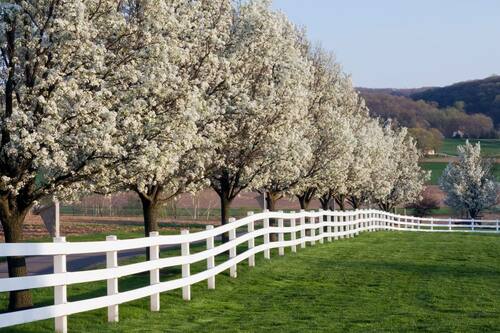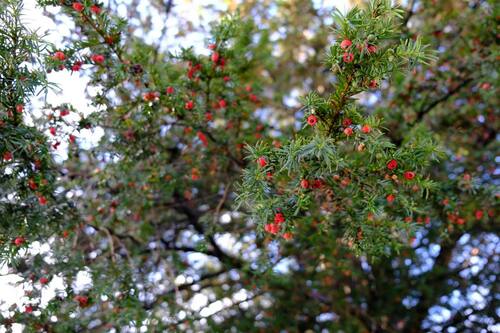The 9 Best Tree Species for Outdoor Projects
Introduction
Choosing the best tree species for outdoor projects is a bit more complicated of a process than some people give it credit for.
Naturally, aesthetics are important. You want something that looks great in the space that it will eventually be living in. Any tree that you use should contribute to the overall feeling that you’re going for. It should feel like an organic part of a much larger project – not an afterthought.
But many people allow the selection process to begin and end with the visual appeal of a tree species, which is a big mistake in more ways than one. Think about the sheer amount of effort alone that goes into selecting these trees. It’s a time-consuming process. They’re inherently expensive. You need to determine exactly how many you need and how to care for them. They have to be physically added to the space you’re working with. There’s truly nothing worse than going through all that effort and fully committing, only to finally realize that you made the wrong choice and were essentially doomed from the start.
That’s why you always want to carefully consider trees for your outdoor projects as a part of the project’s conception. Putting in a bit of extra effort today can help save you from significant problems down the line.
What to Look For in Tree Species for Outdoor Projects: An Overview
By far, one of the most important things that you need to consider when selecting trees for outdoor projects has to do with their geographic suitability. Many people don’t realize that not all trees can thrive in all climates. The best trees for San Francisco Bay Area outdoor projects will be totally different from the best trees for Cleveland, Ohio outdoor projects, for example. The temperature is different. Weather patterns are different. You want the trees that you select to thrive – not die before their time and put you right back in the same situation you’re currently in.
When you’re talking about something like tree selection, it can sometimes be overwhelming in that it feels like your options are overwhelming. They really aren’t, however, as the matter of geographic suitability will begin to whittle your wishlist down fairly quickly.
You should also carefully consider the intended uses of a particular tree species before selecting one for your outdoor project. In essence, don’t start with the tree species at all – start with what you need it to accomplish. Are you looking for something that will add privacy to an outdoor entertainment space at your home, or are you looking for something that will compliment the modern design in the outdoor common area of a commercial environment? These are two wildly different scenarios that will again start to eliminate certain species from consideration by default.
Along the same lines, you should also consider any major advantages that one specific species brings with it over others. If you’re looking at two types of trees that are fairly similar in terms of their visual appearance, don’t be afraid to dive deeper. Is one more durable than the other in that it can withstand harsh weather or being in an area that sees a lot of heavy use? Does one require less maintenance than the other on a seasonal or even annual basis? You need to consider each tree species as a complete package and not let your decisions rest on aesthetic appeal alone.
Finally, you’ll want to further narrow your list based on the availability and cost of each option. Again, if you’re looking at two similar trees, but one is incredibly difficult to get and is thus dramatically more expensive, you have to ask yourself if the aesthetics are worth going to all this extra effort. Some trees are just easier to source than others. When you’re working on an outdoor project that already has a budget attached to it, you have to ask yourself how much of it you’re comfortable devoting to whatever tree species you have your heart set on.
When it comes to something as versatile as nature, it can often seem like “the sky is the limit” in terms of the tree species you can pick from for your next outdoor project. But once you start to think about things logically and pragmatically, that really isn’t the case. This is a good thing, as it can all help make sure that you end up with a solution that meets your needs and exceeds your expectations at the same time.
#1: Crepe Myrtle

Crepe Myrtle is a tree species that thrives in USDA zones 7 through 10. Always consult USDA zones before purchasing a tree (or outdoor plant of any kind) to make sure that it can actually survive in the area of the country that you live in. Crepe Myrtle traditionally grows to a height of between three and 50 feet. They’re considered to be fairly easy to grow and are known for their lovely pink, white, lavender, and red colors. It’s a great tree for small yards in particular and is perfect for when you’re trying to inject a fun, summery look into a space. These trees cost between $25 and $100 or more for a single tree.
These are garden trees that grow at about 24″ per year.
#2: Leopard Tree

The Leopard Tree is perfect for anyone living in USDA zones 10 to 12. They tend to grow to a height of around 12 to 50 feet on average. They’re tall and slender, so while they may not necessarily be a good option if you’re looking to create some additional privacy in your yard, they are perfect for putting a few in your garden, on a patio, or even in a shared space like a courtyard.
They’re not the type of tree that you would expect to blend into the background. Instead, expect them to become a focal point in your larger landscape design. Leopard Trees range in price depending on where you procure them from, but you can typically get them for around $200 per tree in some situations.
These are fast-growing trees that grow in tropical climates.
#3: Mexican Fan Palm

The Mexican Fan Palm is intended to grow in USDA zones 9 to 11. In most situations, they will grow up to 50 feet in height. If your current outdoor project requires you to find something that A) looks great, and B) is highly water efficient, the Mexican Fan Palm is likely just what you’re looking for.
Depending on the size that you purchase, Mexican Fan Palms can range in price from a few hundred dollars to $650 or more .
The Mexican Fan Palm will grow up to three feet per year. It, too, is great for tropical climates – but so long as you live in USDA zone 9 to 11, it can thrive if given the proper resources.
#4: Eastern Redbud

The Eastern Redbud is perfect for USDA zones 5 through 9. Unlike some of the other options on this list, here you have a tree species that only grows about 20 to 25 feet in height. They’re certainly on the smaller side, but that doesn’t make them any less versatile in the right circumstances.
Many people use them for landscaping very close to homes, for example. They won’t outgrow the home itself, and you don’t have to worry too much about the root system doing any long-term damage. Eastern Redbud trees can be found with bare roots at local hardware and home supply stores starting at $32 , although prices obviously increase with age.
The Eastern Redbud is a small, fast-growing, garden tree. However, it will only live between 30 and 40 years on average in warmer climates.
#5: Flowering Dogwood

The Flowering Dogwood is a staple of outdoor projects taking place in USDA zones 6 to 9. They grow up to 30 feet in height and are especially common throughout the northeast.
Not only are they naturally attractive, but many people also love the fact that they don’t need pruning (or much in the way of maintenance of any kind, really). They also take on a great, classical orange and red appearance when things begin to turn in the fall. They also do well in the winter. You can typically find Flowering Dogwood trees for $150 or so per tree .
The Flowering Dogwood grows between 13 and 24 inches every year. It will thrive in cooler climates with at least partial shade. It is considered an “understory tree”.
#6: Crabapple Trees

Crabapple Trees are very popular in USDA zones 3 through 8, and all it takes is one look at the benefits they bring with them to see why. They’re not only great for privacy in and around personal residences, but they’re also perfect for many different wildlife species as well.
Crabapple trees grow to around 40 feet in height over the decades and are about as durable as they come. They do have a fairly significant root system, though, which is why they should be planted around 20 feet from a house or other dwelling. They thrive in both full sun and shade and can often be found for a few hundred dollars per tree in most nurseries.
Crabapple trees grow at a rate of between one and two feet every year. They make great additions to large yards because they thrive in full sun with well-drained soil.
#7: Birch Trees

An Iconic Silver Birch Tree – Photo by Maksim Koshkin
If you live in USDA zones 2 through 9, you’re no doubt already familiar with the beautiful birch tree. They have a distinctive bark that looks great all year round, but that is especially compelling during the winter. Some birch bark takes on a red appearance, while others have bark that is white. Regardless, they’re a perfect way to inject a unique look into virtually any outdoor space.
Birch trees are another variety that go great in both full sun and partial shade. Depending on the size of the tree you’re trying to plant, birch trees can be found for $50 or more per tree in many cases.
Birch trees thrive in cooler environments where they still receive full sunlight. They are considered to be fast-growing trees and can grow at a rate of between one and two feet every year.
#8: Eastern Pine Trees

Perfect for USDA zones 3 through 8, eastern pine trees certainly have a lot going for them. In ideal conditions, they can grow approximately two feet every year – making them one of the fastest growing trees for outdoor projects around. They’re also nothing if not majestic. They can grow up to 80 feet tall and have a spread of about 40 feet once they hit full maturity.
If you close your eyes and think of the types of trees that are synonymous with “winter”, you’re probably imagining an eastern pine tree. Small trees that are ready to plant can be purchased for as little as $20 in many situations.
Eastern Pine Trees commonly do their best in the eastern portion of North America. They are considered to be very fast growers in that they will grow at a rate of about three feet per year.
#9: The English Yew

Last but not least, we have the English Yew – a classical version of the evergreen tree that is optimal in USDA zones 5 through 7. Many agree that due to its distinctive shape and ability to grow to about 40 feet tall, it’s a great way to add some shade to large properties in particular. It can tolerate both full sun and shady spots, so don’t be afraid to experiment. Over time it will also begin to grow small, red berries which attract local animals. So if you’re a wildlife lover that wants to spruce up an area (no pun intended) while also maintaining your privacy, the English yew is for you. They can be found for around $300 to start .
The English Yew will grow at a rate of about one foot every year, making it one of the slower growers on this list. It will do its best in dry, sub-humid climates, which is why it is best planted in USDA zones 5 through 7 as mentioned above.
The Arborist Now Approach
At Arborist Now , we offer services like milling and others to clients all throughout the area on a regular basis. More than anything, we pride ourselves on our ability to take the time to learn each client individually. There is no “one size fits all” approach to these types of outdoor projects. We want to learn exactly what it is that you’re trying to accomplish, why those goals are so important to you, and (most critically) what we can do to help.
In our outdoor projects we use durable trees for landscaping like redwood , eucalyptus , and others for many of the reasons outlined above. Of course, the best regional trees for outdoor use will vary wildly depending on the region you’re talking about, which is why our process always begins exactly the way it should: with a conversation between you and one of our experts.
So if you’d like to find out more information about the best tree species for outdoor use, or if you just have any additional questions that you’d like to go over with someone in a bit more detail, please don’t hesitate to contact the team at Arborist Now today. We also sell slabs and other resources that can help make sure your next project is a success, so if you’re ever in the neighborhood, please feel free to stop by.
Frequently Asked Questions
1. How long is the process of planting a tree in my area?
Given how time-consuming it can often be to find the best tree species for outdoor projects, many people think that the “hard part” is officially done at that point. But any professional arborist will tell you that planting a tree is not as simple as flipping a proverbial light switch. It can actually take up to two full weeks to plant a tree in your yard.
Naturally, this will depend on a many different factors, including the size of the tree and the species you selected. Still, you’ll need to prepare the ground and the surrounding area, dig a hole, plant the tree, keep it watered, etc. Multiply this amount of time and effort by the total number of trees you’re planting, and you can begin to get a sense of just how long it will ultimately take.
2. What are some of the possible pitfalls that you can avoid while planting trees as a part of your outdoor project?
One of the biggest mistakes that people often make when planting trees has to do with putting them too close to either other plants or structures that are already there. If you plant trees that require sunlight in the immediate vicinity of tall trees that already exist, they’ll essentially be starved of those nutrients they need. They won’t grow as quickly as they should and will likely have poor overall health as well.
Another major mistake that people make involves planting trees in areas where a lot of clay or concrete is already present. Clay and concrete are good for many things – holding water and nutrients to help trees grow strong and healthy is not on that list. This, too, is a seemingly simple mistake that can cause your newly selected trees to grow poorly and essentially undo a lot of your hard work.
3. Is it possible to plant trees too frequently?
Believe it or not, yes – in some cases, it is absolutely possible to do more long-term harm than good by planting trees in a particular area more frequently than the environment can support. This is another one of the reasons why you want to take great care to make the right selection the first time regarding any tree species you’re thinking of using. As a rule of thumb, most professional arborists say that you should only plant trees every three to five years. Obviously, there are exceptions to every rule and if you have questions about your own area and what it can support, you are encouraged to speak to a professional.
4. What are the major benefits that come with planting trees as a part of your outdoor project?
Once you’ve selected a tree species that you’re happy with and have incorporated it into your overall design, you get a number of advantages almost immediately. Properly selected trees do more than just provide shade. They also go a long way towards reducing air pollution, helping to support local wildlife, and helping to keep the planet clean through sustainability best practices. If you’re planting trees at a private residence, it’s also important to note that the right tree species can absolutely help improve your property value, too.
5. What happens if you don’t plant a tree correctly on the first try?
If your plan is to plant your selected tree species yourself as a part of a larger DIY project, understand that there is certainly a risk that you might run into an issue. If you don’t plant the tree properly as per the requirements of the species, the first thing you’ll want to do is dig up the tree’s root system. Then, move it to the desired location in the yard. Remember that the root system will expand over time, so be sure to consider any nearby elements like hardscaping that could become a potential obstacle in the future.


